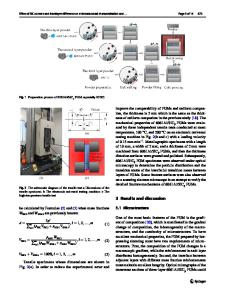Effect of SiC Dispersed Composition on Physical and Mechanical Properties of Reaction-Sintered Silicon Carbide
- PDF / 281,692 Bytes
- 5 Pages / 594 x 792 pts Page_size
- 100 Downloads / 386 Views
Vol. 61, No. 2, July, 2020
EFFECT OF SiC DISPERSED COMPOSITION ON PHYSICAL AND MECHANICAL PROPERTIES OF REACTION-SINTERED SILICON CARBIDE S. N. Perevislov,1 M. A. Markov,2 A. V. Krasikov,2 and A. D. Bykova2,3 Translated from Novye Ogneupory, No. 4, pp. 41 – 45, April, 2020.
Original article submitted January 17, 2020. Dense ceramic materials of silicon carbide with high mechanical properties are obtained by reaction sintering. The effect of different dispersed compositions of silicon carbide powders on the microstructure, grain size after sintering, and physical and mechanical properties is shown. Keywords: silicon carbide, reaction sintering, physical and mechanical properties, reaction-sintered silicon carbide.
goal of the present work was to prepare high-density ceramic SiC materials by reaction sintering using the optimum disperse composition of SiC powders.
INTRODUCTION Silicon carbide possesses an exceedingly broad property set such as high strength and thermal conductivity, low thermal coefficient of linear expansion (TCLE), stable levels of mechanical properties over a wide temperature range, resistance to oxidation up to critical temperatures, and high hardness that enable SiC to be used as wear-resistant and ultrahard materials operating under extreme temperatures and in aggressive media [1, 2]. Materials based on SiC are produced in various ways, i.e., hot pressing and liquid-phase and reaction sintering. The best properties are attained by using hot pressing. However, it is not widely used because of high energy consumption and technologically complex production [3]. Reaction sintering, which produces materials with the lowest levels of mechanical characteristics although it has several advantages such as the ability to use cheaper starting powders of greater particle sizes, low sintering temperatures, and production of practically shrink-free items, is technologically simple. This enables reaction sintering to be used to fabricate parts of any complexity and configuration on an industrial scale [4]. The 1 2
3
EXPERIMENTAL Reaction-sintered (self-bonded) SiC was prepared by liquid-silicon impregnation of porous blanks including particles of primary silicon carbide SiCI and carbon via dissolution of carbon and its transport through the Si melt and crystallization of secondary silicon carbide SiCII on the surface of primary particles [5, 6]. SiC powders of various granulometric compositions were used for the closest packing of particles during the formation of items [7]. Table 1 presents the compositions of the studied materials. Carbon (15 mass%, >100%) was added to all compositions of the material during mixing of the starting components. The SiC powder particle size was determined using a Mastersizer 2000 laser particle-size analyzer and was d0.5 for M40 of 27.8 mm; M28, 14.8 mm; and M5, 3.7 mm. SiC powders in the required ratio were mixed in a drum mixer with technical carbon. The mixture was plasticized and granulated. Samples of dimensions 5 ´ 5 ´ 45 mm were prepared from the charge by semi-dr
Data Loading...



